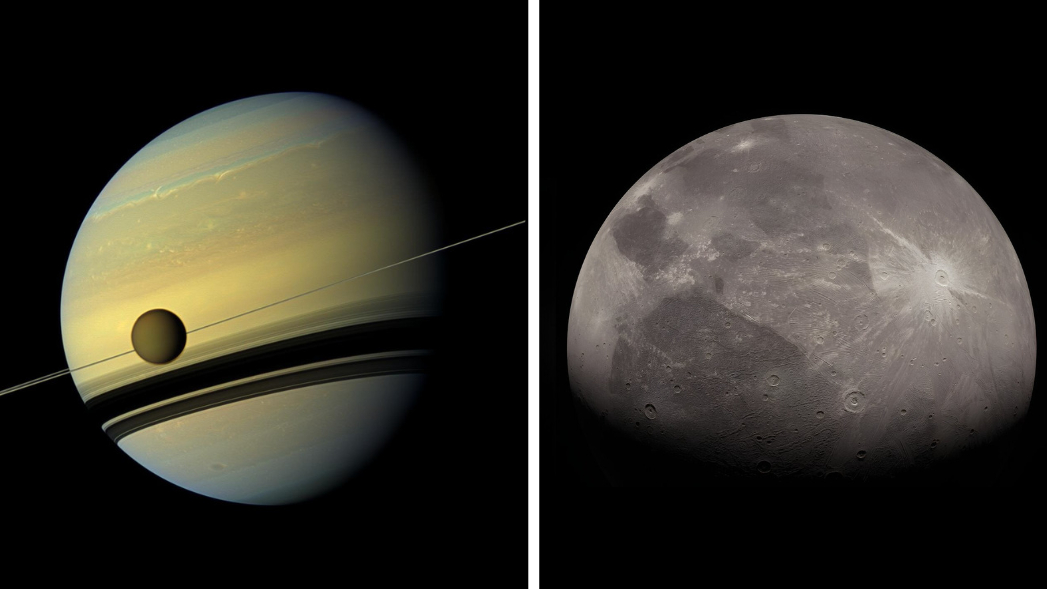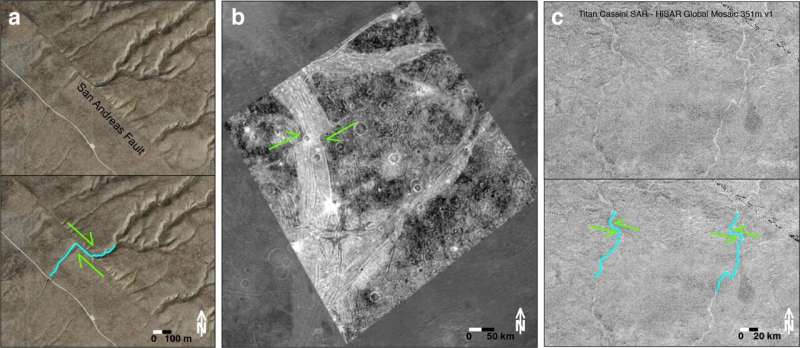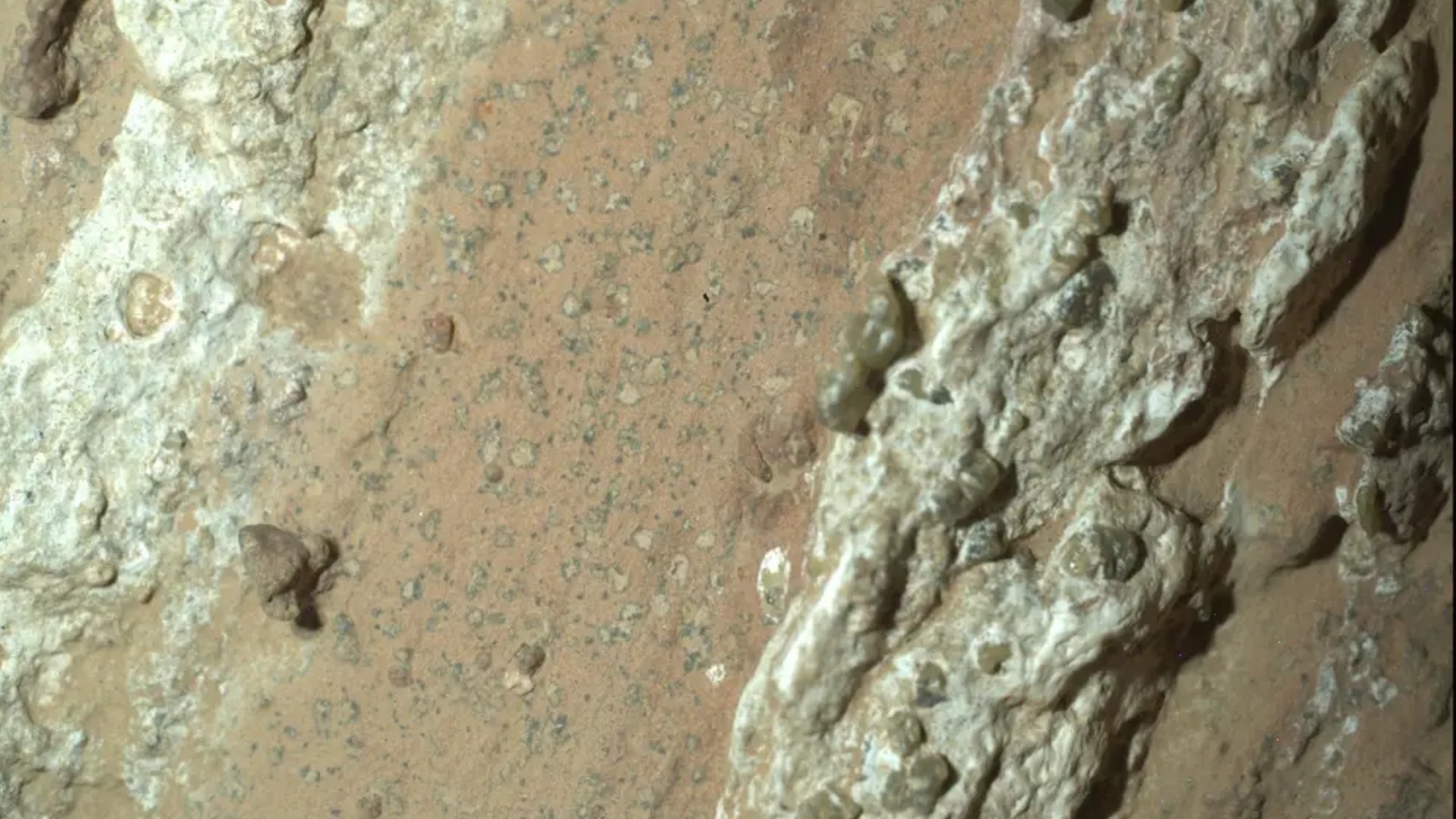Evidence of alien life may exist in the fractures of icy moons around Jupiter and Saturn
"That type of faulting can facilitate the exchange of surface and subsurface materials through shear heating processes, potentially creating environments conducive for the emergence of life."

Scientists are investigating specific geological features on the largest moons of both Jupiter and Saturn that could be ideal spots for the emergence of life elsewhere in the solar system.
The team, led by researchers from the University of Hawaii at Mānoa, looked at what are called "strike-slip faults" on the Jovian moon, Ganymede — the solar system’s largest moon, bigger even than the planet Mercury — and Saturn's moon, Titan. Faults like these happen when fault walls move past each other horizontally, either to the left or the right, with a famous example here on Earth being the San Andreas fault. It's sort of like a giant crack, rift, or certain type of crevice in the ground.
Such seismic features are generated on these icy moons, scientists believe, when these bodies orbit their parent gas-giant planets. The planets' immense gravitational influences generate tidal forces that squash and squeeze the moons, inevitably flexing the natural satellites' surfaces. Plus, these tidal forces aren’t very consistent because the orbits of both moons are elliptical, meaning they are sometimes closer to Saturn or Jupiter. Other times, they're much farther away. That, in turn, leads to even stronger tidal forces.
"We are interested in studying shear deformation on icy moons because that type of faulting can facilitate the exchange of surface and subsurface materials through shear heating processes, potentially creating environments conducive for the emergence of life," Liliane Burkhard, lead author of the research and a scientists at the Hawaii Institute of Geophysics and Planetology, said in a statement.
Related: NASA’s Juno probe detects organic compounds on huge Jupiter moon Ganymede
Strike-slip faults on Titan
Saturn’s moon, Titan, has surface temperatures of around minus 290 degrees Fahrenheit (minus 179 degrees Celsius). This is incredibly cold — cold enough that the water of this moon actually plays the role of rock. It can crack, deform and, ultimately, form faults.
During its flybys of Titan, NASA’s Cassini spacecraft was able to determine that this moon of Saturn may have liquid water oceans tens of miles beneath its thick shell of ice. Additionally, Titan is the only solar system moon with a dense, Earth-like atmosphere, meaning it has a similar hydrological cycle with methane clouds, rain and liquid flowing across the surface to fill lakes and seas. For this reason, Titan is already considered one of just a few bodies in our solar system that could support life — as we know it, at least.
Breaking space news, the latest updates on rocket launches, skywatching events and more!
When the NASA Dragonfly mission (which launches in 2027) arrives at Titan in 2034, it will send a rotorcraft lander to fly across the frigid surface of this moon in an effort to hunt for those potential biological signs. That doesn't exactly mean it'll search for bug-eyed aliens, however. At the very least, the team hopes the lander will detect the chemical building blocks of life we're familiar with.
The Dragonfly mission is initially set to land at the Selk crater area on Titan, a region that is also of interest to Burkhard and the team. This is because when calculating the stress exerted on Titan’s surface as a result of tidal forces, the researchers weren't only focused on whether there might be signs of extraterrestrial life on the ground. They also explored the chance that the Selk crater region could be subjected to shear deformation to figure out whether it's a safe landing site option for Dragonfly in the first place.
"While our prior research indicated that certain areas on Titan might currently undergo deformation due to tidal stresses, the Selk crater area would need to host very high pore fluid pressures and a low crustal coefficient of friction for shear failure, which seems improbable," said Burkhard. "Consequently, it’s safe to infer that Dragonfly won’t be landing in a strike-slip ditch!"
Burkhard and colleagues also looked at the geology of the Jovian moon, Ganymede, to investigate the icy body’s history of tidal stress. In particular, the team looked at a bright region in the northwest of Ganymede called Philus Sulcus, which is composed of parallel sets of fractures.
The researchers basically looked at available high-resolution observations of the area to find that there were different degrees of tectonic deformation in bands of light terrain that cross over each other. The cross-cutting nature of these bands indicated to Burkhard and colleagues the existence of three distinct eras of geological activity — ancient, intermediate, and young.
"I investigated strike-slip faulting features in intermediate-aged terrain, and they correspond in slip direction to the predictions from modeling stresses of a higher past eccentricity," said Burkhard. "Ganymede could have undergone a period where its orbit was much more elliptical than it is today."
When investigating other parts of Philus Sulcus, the team found the direction of slip features to have different alignments. This implies these features may have been generated by processes other than high tidal stress. "So, Ganymede has had a tidal 'midlife crisis,' but its youngest 'crisis' remains enigmatic," Burkhard added.
The geologic investigations undertaken by this team and others are vital for informing the missions of spacecraft that aim to explore solar system moons like Titan and Ganymede. said Burkhard.
“Missions such as Dragonfly, Europa Clipper, and ESA’s JUICE will further constrain our modeling approach and can help pinpoint the most interesting locations for lander exploration and possibly for gaining access to the interior ocean of icy moons,” Burkhard concluded.
The team’s research is published across two papers in the journal Icarus.

Robert Lea is a science journalist in the U.K. whose articles have been published in Physics World, New Scientist, Astronomy Magazine, All About Space, Newsweek and ZME Science. He also writes about science communication for Elsevier and the European Journal of Physics. Rob holds a bachelor of science degree in physics and astronomy from the U.K.’s Open University. Follow him on Twitter @sciencef1rst.

